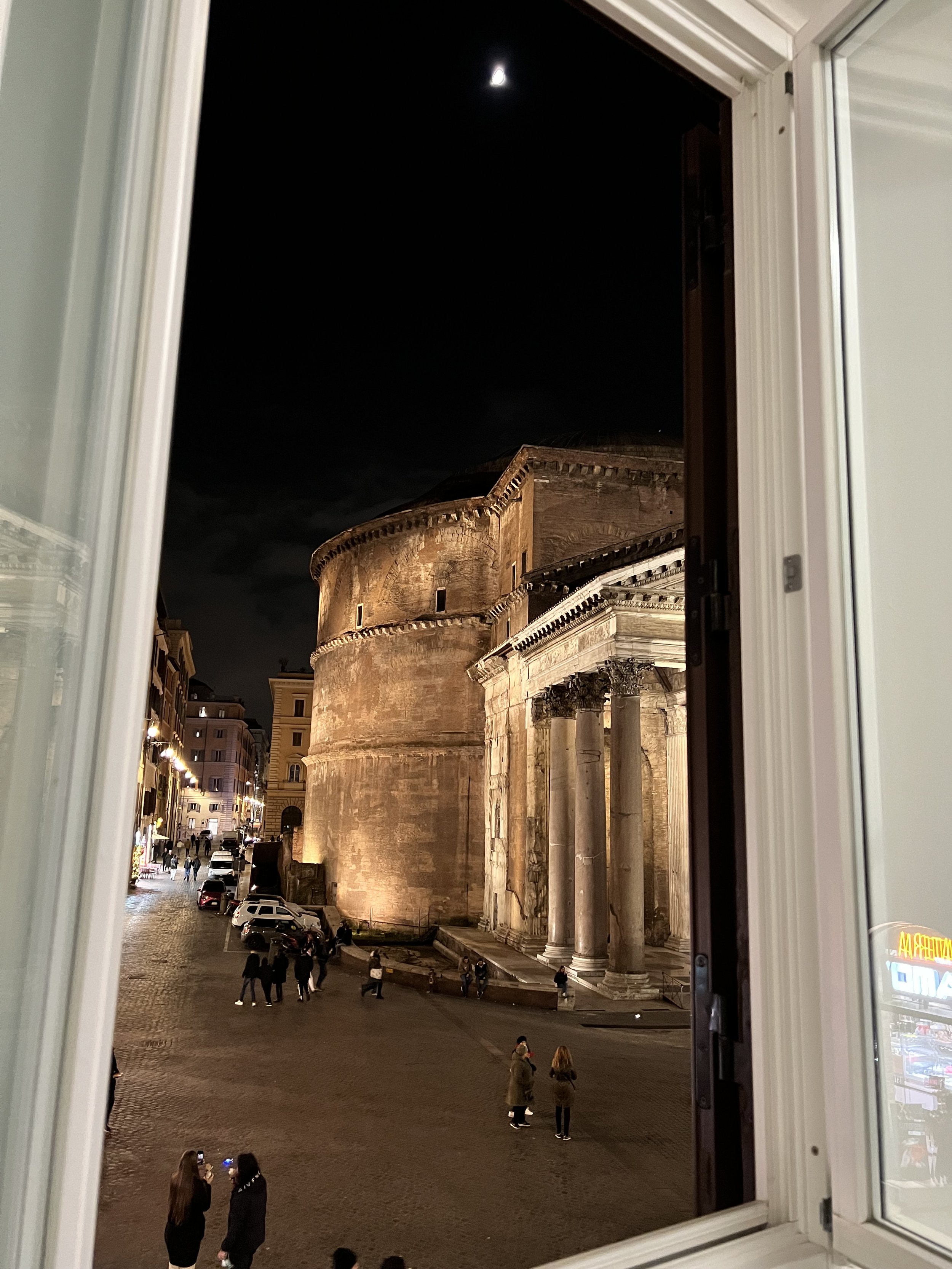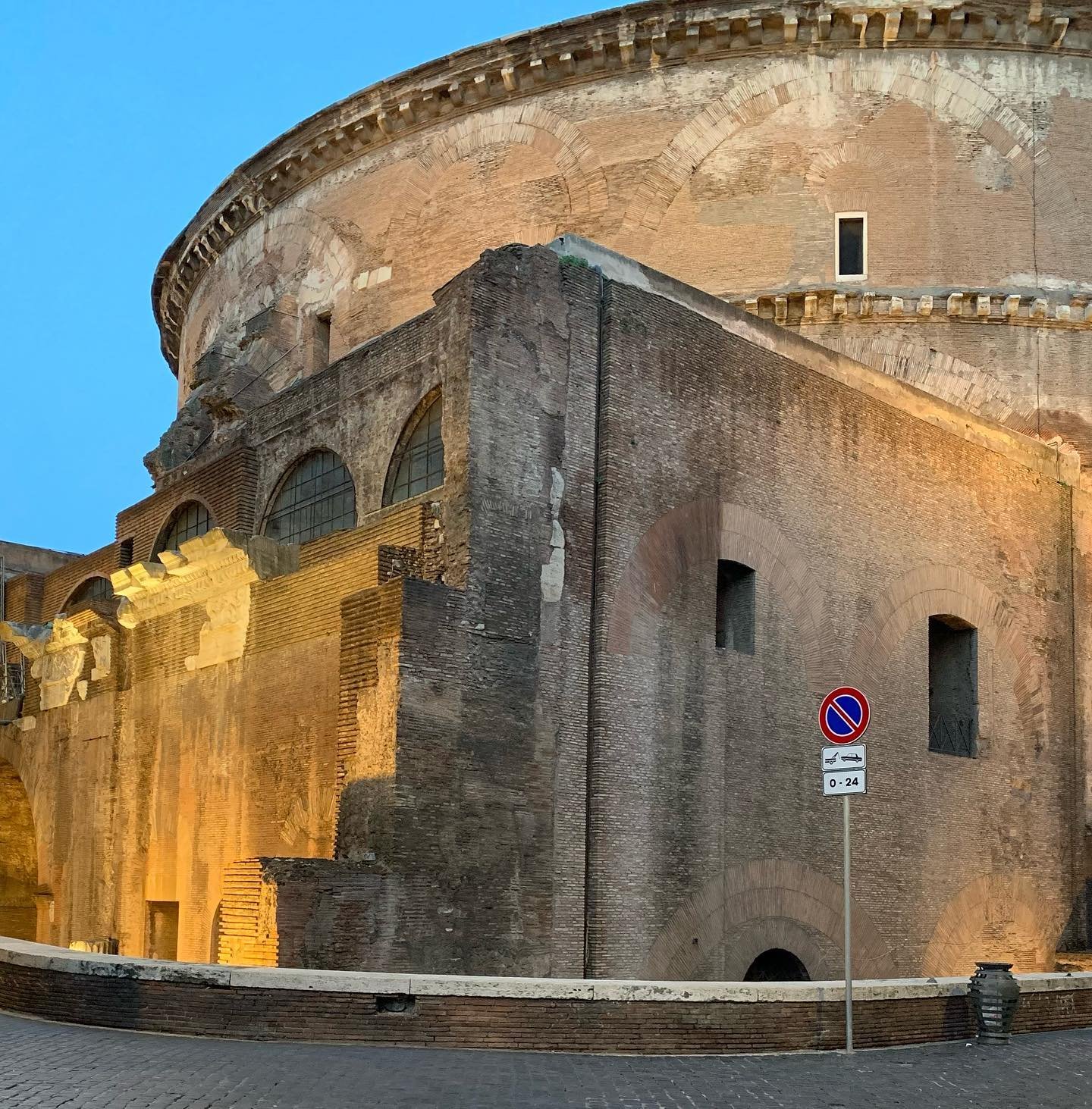
PANTHEON
128 CE
M.AGRIPPA.L.F.COS.TERTIUM.FECIT
THE Pantheon
The Pantheon, has been forever standing in this same place for nearly 2,000 years. As remarkable as it is, one can’t help but wonder and imagine how it must have been when it was first unveiled to the public in 128CE.
One aspect I never thought about until this visit was the outside rotunda, previously I had noticed how naked it looks, stripped of all its smooth marble centuries ago, leaving pockmarked and porous brick. In the 2nd century there were buildings right up next to it on both sides, you can see this in some small scale topographic layouts on view in certain museums, like the Arc Pacis. It seemed weird to me to cramp this beautiful building in until I read recently how that was part of its magic. For by blocking the eye of the rounded nature of the building what you see is the rectangular entrance, once entered and past its giant bronze doors you are transported to a total spherical world.
The inner dome, round as it is, is made up of square coffers which architects explain distribute the load of the structure, making it lighter, each coffer you have to imagine had a bronze star affixed so that the beam of sunlight from the oculus would shine and gleam upon them. The outer dome itself was gilded in bronze as well (today it’s dull lead) and the portico girders were too clad in bronze. The triangular facade of the portico facing the piazza would have had a bronze eagle with wings outstretched glittering in the sun or moon light and the background smooth marble.
The massive and perfect roundness of the interior still dazzles today but imaging what it must have been like to have it unveiled to you in this surprising manner!
For reasons I don’t fully understand the Pantheon’s night sky is teaming with seagulls, where I come from seagulls caw endlessly but here in Rome they fly silent, and only at night. You can see some white blurry bits in my pictures here set against the moonlight. At first I thought they must be bats, part of me really wanted them to be bats. But they are just seagulls, the night guardsmen of Imperial Rome.
As a card-carrying Pantheon fan I am one of the many throughout modern history to lament the pieces taken away. A building of the Imperial Age's only chance of survival is to be adaptable to modern needs, otherwise it would have crumbled and decayed centuries ago, so from a temple to all Gods transformed to a church of just one was a necessary trade off for us to have it at all. That said, the Catholic Church employs saints the same way the Romans attributed gods… the patron Saint of this or patron Saint of that is really no different than a polytheistic deity in my mind. But what I find sad is all the rich material stripped away from the Pantheon (and so many buildings of its period).
It was a couple of popes who were responsible for stripping so much from the Pantheon. First it was Clement II in the 7th century who robbed the dome's bronze to be carted off to Constantinople, he was part of a succession of rulers who abandoned Rome and were keen on allowing it to vanish. Much later in the renaissance the history hating Urban VIII took away the bronze rafters and some turned into Bernini’s twisted Baldachin still a focal point inside St. Peter’s, the rest were melted down and recast as cannonballs used in the 30 years war. No one knows what happened to the eagle.
Urban VIII is hard to like not only for this but he also opposed Galileo and Copernicus. Galileo’s trial was held just one block away at the Santa Maria sopra Minerva, in the shadow of the Pantheon.
𝘲𝘶𝘰𝘥 𝘯𝘰𝘯 𝘧𝘦𝘤𝘦𝘳𝘶𝘯𝘵 𝘣𝘢𝘳𝘣𝘢𝘳𝘪, 𝘧𝘦𝘤𝘦𝘳𝘶𝘯𝘵 𝘉𝘢𝘳𝘣𝘦𝘳𝘪𝘯𝘪 was a Latin saying which translates to “What the Barbarians started the Berberini finished” Berberini was Urban’s family name.
What is often overlooked is how so many of the great artists of the renaissance were also responsible for stripping marble facades off as many buildings as they could find. And the Romans were guilty too of doing the same thing to Egypt, robbing their obelisks and pillars wholesale to bring to Rome. So history is a lot of atrocities added up to where we are today.
These are the views from the hotel I like to stay at in Rome. Albergo Abruzzi.
Here are some detail images I took close up. There are two different kinds of marble used in the columns, one grey the other pink, sourced from different quarries in Egypt. It’s amazes me that these columns floated on barges down the Nile River across the Mediterranean then up the Tiber to get here.
I’m the last photo is a bit of scratched in graffiti, I’m sure it’s my imagination but it looks like it’s dated 1090, not sure if they would have been talking about SPQR in that year, since it had long been gone by then.




















